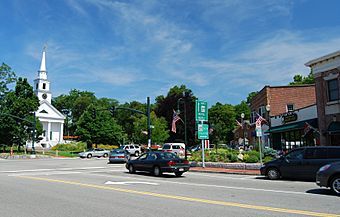Sharon Historic District (Sharon, Massachusetts) facts for kids
Quick facts for kids |
|
|
Sharon Historic District
|
|
 |
|
| Location | Sharon, Massachusetts |
|---|---|
| Built | 1842 |
| Architectural style | Colonial Revival, Greek Revival, Other |
| NRHP reference No. | 75000296 |
| Added to NRHP | August 22, 1975 |
The Sharon Historic District is a special area in Sharon, Massachusetts. It's like a time capsule showing how the town looked long ago. This district is found on both sides of North Main Street, from Post Office Square to School Street. It includes the very first part of Sharon that was planned out. This was when Sharon started as a church area (called a parish) of Stoughton in 1740. Because of its history, this district was added to the National Register of Historic Places in 1975.
Exploring Sharon's Historic Center
This historic district helps us understand Sharon's past. The town of Stoughton was officially formed in 1726. It was created from a larger area called Dorchester. Later, the southern part of Stoughton became its own separate area. This area was named Stoughtonham in 1765. Then, in 1783, it was renamed Sharon.
The center of Sharon began around 1740. This was where the first church building, known as a colonial meeting house, was built. Today, the 1842 Greek Revival Unitarian Church stands in that same spot.
What You'll See in the District
The most important old buildings that are still standing are on one block of North Main Street. This block is between Post Office Square and School Street. In this area, you can find six historic houses and two churches. There is also the town library, which is the only public building in the district. The library is a beautiful Georgian Revival style building. It was built in 1914 with money from a famous helper, Andrew Carnegie.
Oldest Homes and Churches
The oldest building in the Sharon Historic District is the Dennett House. It was built around 1753. This house replaced an earlier church home that was destroyed by fire. You can find it at the northwest corner of the district.
Near the Dennett House and the Unitarian Church are three other houses:
- The First Congregational Church Parsonage was built in 1905. It's a Colonial Revival style building.
- The Dr. Griffin Office was also built in 1905. It started as a private home.
- The Morse House, built in 1805, is south of these homes. It was the very first brick building in Sharon.
Across the street from the Morse House is the First Congregational Church. This church was built in 1839 in the Greek Revival style. The library is just south of this church. The church is connected to a Colonial Revival house from the early 1900s. Another similar house stands to its north, across from the Dennett House.



